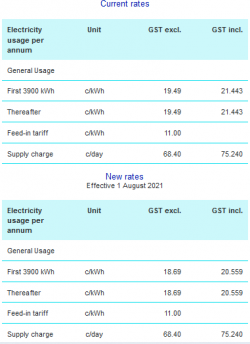Yours is a flat rate
Mine is a time of use. If I converted mine to flatrate using most recent bill ( = same as avg cost per kWh), I get 18.93c / kwh
But AGL is ahead because of the FiT 11c vs 7.6c and the deeply discounted supply charge 0.7542 instead of 1.5455
AGL offers for my address are: charges 1.42 supply charge, 7C FiT and less attractive usage tariff than my current provider
I showed a simple spreadsheet layout for comparing plans a few months back - worthwhile using as it makes a big difference to use at least a year's bills since Winter/Summer consumption can vary massively for people.
________________________________
Not necessarily the best AGL offer for your address though.
From my experience over the last 7 or 8 years - none of the power comparison sites actually work effectively for the public. None. Not even a couple on 'solar sites' which I have been trying to get improved, or at least highlight their failings. Hence my reliance on our own spreadsheet.
For example - with our AGL plan it did not show up on ANY of (6 I think it was) comparison sites including the Fed Govt one (IMHO that is one of the worst for the public btw).
If you go to the companies' own sites and use their tools - the results that come up often 'unintentionally' hide the best results for people. Total coincidence.
What I found, by accident, when I decided to scroll down to the very bottom of the results was that just like when doing a 'search' using Google et al - that the best results are often not the ones that show up first. This has been widely documented for Google (for example), and I am not talking about the advertising 'results' shown. Historically, the unbiased search results appear around the 30th listing, aka mid 2nd page of results.
The AGL offer was around the 2nd or 3rd to last after some AGL business offerings and many residential plans. When I then rang about it - I actually got a plan (the one shown) that was slightly better (3rd decimal place for daily supply charge & 3rd decimal place for usage).
So if you scrolled down a little you got several residential plans, then several business plans and then another batch of residential plans that were better (cheaper) options.
Being a pedant. I then went back to Origin, Dodo (and others) to see if there was a similar outcome - yes there was for most, but not all of the sites.
















